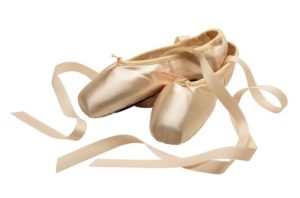
EN POINTE at any age? a professional perspective
When they majority of us think of ballet dancing, for females especially, we typically think of dancing in pointe shoes. And yes, there are some men and non-binary folks who also dance en pointe.
A traditional pathway to pointe work begins with several years of structured ballet training as a child and being judged by a teacher as ready. In the most ideal world this would be around puberty when growth plates are closed, though a little earlier may be reasonable.
But what if you started ballet as an adult? Is it too late? My answer is a resounding NO with some very important and specific caveats. Safely and successfully dancing in pointe shoes requires a certain level of strength and mobility. Additionally, you must have proper alignment and mastery of ballet fundamentals. Ultimately a ballet teacher or other qualified professional should determine if you are pointe ready.
Dancing in pointe shoes can be very rewarding and is not so fun or really safe, if you cannot get on your box (the tip of the shoe). The ability to do that, aside from strength (more about that later) comes from a combination of the mobility in your ankle joint, that is largest factor, and the mobility in your foot. The ideal is that if you are en pointe a straight line could be drawn from the tip of your toes that goes through your ankle joint and up you leg. I recall I woman I danced with who had feet as flat as pancakes and good ankle mobility. She did excellent pointe work. More typically the arch in the foot also contributes.
For years I believed that if you could not achieve that particular straight line, pointe work would be very challenging. Then I got into watching pointe shoe fitting videos by Josephine Lee of the Pointe Shop. I observed that with enough mobility in the foot, and the right shoe, it is reasonable to dance en pointe. You still need to be on top of the box, though the line starting at the tips of your toes will be parallel to and a bit in front of that ideal described.
We are lucky to live in an era where there are so many styles of pointe shoes available. I highly recommend being fitted by someone skilled in doing this. Virtual fittings are possible.
Regarding mobility …
Here is a favorite exercise of mine to work on that ankle mobility. Get on your hands and knees with the tops of feet on the ground (no tucked toes.) Gently sit back towards your heels until you feet a stretch across the ankles. If like me your two ankles are quite different in flexibility you can tuck toes of one foot and leave the other top of foot on the ground and then reverse. If you don’t get a stretch, you probably already have pretty good ankle mobility.
Regarding alignment …
If your are rolling to the outside or the inside of your foot on flat and especially on releve, you are going to have a hard time doing anything on pointe. Rolling is often the result of using more turn out than is currently available at your hip joints. Good alignment involves the ability to work from a position where the pelvis and spine are neither tucked under or overly arched. From there appropriate turn out actually becomes easier. With this in place building strength comes next. More accurately in part these are worked simultaneously.
About strength ….
Doing lots of releves in ballet flats or socks definitely helps prepare you for pointe. It is important that you feel your weight evenly across the ball of your foot and not roll/sickle in or out. Also be aware of ending up leaning back as you rise.
There are some supplementary exercises you can also do. Exercise bands are widely available in a variety of resistance levels. Choose one that allows you to reasonable do about 30 repetitions of the following …
Rest your heel on the ground.
- Resist pulling your forefoot towards the midline (sickling)
- Resist pulling your forefoot away from the midline (winging)
- Pointing your foot into the band. (This is of most benefits the foot muscles important in articulating your feet en pointe. The calves require body weight exercise.)
I have a very favorite exercise. It does require a partner. You the dancer stands in a solid releve position. The partner carefully tries to push your heel in and out while you maintain your solid position.
FINALLY THE ADVANTAGES OF STARTING POINTE AS AN ADULT
- You don’t have to wait as long. Children have open growth plates and typically should ideally wait until puberty (or at least after several years of study) before starting pointe. An adult with a couple of years of quality consistent training – provided mobility, strength and alignment are good, should be fine.
- As an adult you likely have more focus and a better conscious sense of your body in ballet helping you to learn more quickly.
So, if pointe work is of interest, and you don’t have any specific structural limitations or significant injury history follow the above recommendations and a new pair of pointe shoes can be yours.
A version of this article appeared in the Slipper Edit, a newsletter published by Veronica Vicorra who is an amazing champion of adult, especially relatively beginning dancers. Veronica inspired me to share what I can to help dancers thrive. Do visit https://www.veronicaviccora.com
